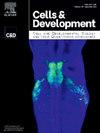出生后主动脉发育的转录调控。
IF 3.9
4区 生物学
Q4 Biochemistry, Genetics and Molecular Biology
引用次数: 0
摘要
在出生后的发育过程中,主动脉的几何形状、组成和机械特性发生了巨大变化。这些变化必然是由转录变化驱动的,既有基因编程变化,也有机械响应变化,但目前还没有对转录特征和生物力学表型的时程变化进行仔细比较。在这里,我们发现,正常出生后小鼠主动脉基因表达差异最大的时期发生在三周龄断奶之前,但此后许多转录本都发生了重要变化。我们发现了六种一般的时间模式,包括转录本单调地下降到较低或上升到较高的稳态值,以及在断奶前或断奶附近达到峰值或骤降的转录本。我们发现,各个分组中的不同转录本随着时间的推移具有很好的相关性,而且这些分组的子集与预期参与机械感应的不同生物力学指标的发育进程具有很好的相关性。特别是,弹性蛋白和弹性蛋白相关糖蛋白基因的表达往往与收缩应力与舒张应力之比密切相关,而胶原纤维基因则与收缩应力的日变化率密切相关,机械感应蛋白基因往往与收缩应力本身密切相关。我们的结论是,具有不同时间表达模式的不同基因分组与心壁力学的不同测量结果有很好的相关性,因此强调了对出生后发育进行与年龄相关的基因特异性计算建模的必要性。本文章由计算机程序翻译,如有差异,请以英文原文为准。
Transcriptional regulation of postnatal aortic development
The aorta exhibits tremendous changes in geometry, composition, and mechanical properties during postnatal development. These changes are necessarily driven by transcriptional changes, both genetically programmed and mechano-responsive, but there has not been a careful comparison of time-course changes in the transcriptional profile and biomechanical phenotype. Here, we show that the greatest period of differential gene expression in the normal postnatal mouse aorta occurs prior to weaning at three weeks of age though with important evolution of many transcripts thereafter. We identify six general temporal patterns, including transcripts that monotonically decrease to lower or increase to higher steady state values as well as those that either peak or dip prior to or near weaning. We show that diverse transcripts within individual groupings correlate well over time, and that sub-sets of these groups correlate well with the developmental progression of different biomechanical metrics that are expected to be involved in mechano-sensing. In particular, expression of genes for elastin and elastin-associated glycoproteins tend to correlate well with the ratio of systolic-to-diastolic stress whereas genes for collagen fibers correlate well with the daily rate of change of systolic stress and genes for mechano-sensing proteins tend to correlate well with the systolic stress itself. We conclude that different groupings of genes having different temporal expression patterns correlate well with different measures of the wall mechanics, hence emphasizing a need for age-dependent, gene-specific computational modeling of postnatal development.
求助全文
通过发布文献求助,成功后即可免费获取论文全文。
去求助
来源期刊

Cells and Development
Biochemistry, Genetics and Molecular Biology-Developmental Biology
CiteScore
2.90
自引率
0.00%
发文量
33
审稿时长
41 days
 求助内容:
求助内容: 应助结果提醒方式:
应助结果提醒方式:


